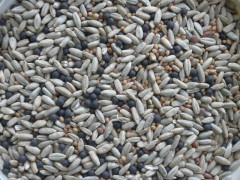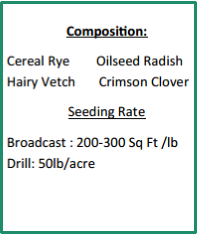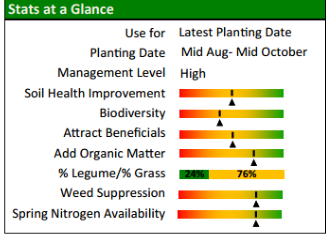WCS Garden Late Cover Mix

The WCS Garden Late Cover Mix is a simple cover crop mix designed to plant with a minimal window prior to first frost and still provide the benefits of a cover crop. The combination may be planted up until mid October in Zone 5. It will loosen topsoil, protect your soil from winter erosion and nutrient loss, suppress weeds and provide mulch in the spring and food for soil micro and macro organisms which are crucial for healthy soil.
This mix is winter hardy and will continue growth in the spring.
This mix is winter hardy and will continue growth in the spring.
Planting
Plant in mid August to mid October. May be planted around mature warm season vegetables to begin protecting the soil before your garden is put to rest or into bare ground as soon as vegetables are exhausted. If necessary, trim up plants to ensure sunlight and water to germinating seedlings. Combine seeds with provided inoculant and plant within 30 days of mixing. Lightly broadcast the seeds and work into the top one half inch of soil or cover with mulch or compost. Hand held broadcast spreaders are ideal for application. Drop spreaders are not recommended with the varied seed sizes. Seeds should have moisture equivalent to 1” of rainfall per week until seedlings are established. Do not fertilize cover crops as this slows down the nitrogen fixation of the legumes.
If you have seed left over, reseal the bag and store seed in cool location out of the sun. If planting after 30 days, the inoculant will no longer be viable and you should purchase fresh for your cover crop to fix nitrogen effectively. We are able to provide replacement packets.
Management
The Cereal Rye, Hairy Vetch and Crimson Clover in this mix will over winter and continue growing in the spring to add a flush of organic material and nitrogen as well as early blooms for beneficial insects and pollinators. The live plants can be terminated at the full bloom stage, approximately mid to late May, by tilling, mulch mowing, clipping or herbicide. Follow with warm season vegetables.
Until cover crops have been in use for several years and your soil structure is rehabilitated and healthy levels of microorganisms are present, expect to water and fertilize vegetables at current levels, cutting back as soil health and organic matter levels improve.
Remember
Tilling will accelerate loss of nitrogen and consumption of organic matter by soil bacteria and will retard soil health.
Avoid tilling whenever possible. Never leave your soil naked!
Ideally you should test soil for nutrient levels and organic matter content every 3 to 5 years.
Note: Micronoc inoculant contains a broad spectrum of nitrogen fixing rhizobia bacteria as each legume requires a different strain.
Micronoc also contains mycorrhizal fungi to aid plants root nutrient uptake. This product is OMRI approved for use in organic.
Plant in mid August to mid October. May be planted around mature warm season vegetables to begin protecting the soil before your garden is put to rest or into bare ground as soon as vegetables are exhausted. If necessary, trim up plants to ensure sunlight and water to germinating seedlings. Combine seeds with provided inoculant and plant within 30 days of mixing. Lightly broadcast the seeds and work into the top one half inch of soil or cover with mulch or compost. Hand held broadcast spreaders are ideal for application. Drop spreaders are not recommended with the varied seed sizes. Seeds should have moisture equivalent to 1” of rainfall per week until seedlings are established. Do not fertilize cover crops as this slows down the nitrogen fixation of the legumes.
If you have seed left over, reseal the bag and store seed in cool location out of the sun. If planting after 30 days, the inoculant will no longer be viable and you should purchase fresh for your cover crop to fix nitrogen effectively. We are able to provide replacement packets.
Management
The Cereal Rye, Hairy Vetch and Crimson Clover in this mix will over winter and continue growing in the spring to add a flush of organic material and nitrogen as well as early blooms for beneficial insects and pollinators. The live plants can be terminated at the full bloom stage, approximately mid to late May, by tilling, mulch mowing, clipping or herbicide. Follow with warm season vegetables.
Until cover crops have been in use for several years and your soil structure is rehabilitated and healthy levels of microorganisms are present, expect to water and fertilize vegetables at current levels, cutting back as soil health and organic matter levels improve.
Remember
Tilling will accelerate loss of nitrogen and consumption of organic matter by soil bacteria and will retard soil health.
Avoid tilling whenever possible. Never leave your soil naked!
Ideally you should test soil for nutrient levels and organic matter content every 3 to 5 years.
Note: Micronoc inoculant contains a broad spectrum of nitrogen fixing rhizobia bacteria as each legume requires a different strain.
Micronoc also contains mycorrhizal fungi to aid plants root nutrient uptake. This product is OMRI approved for use in organic.



